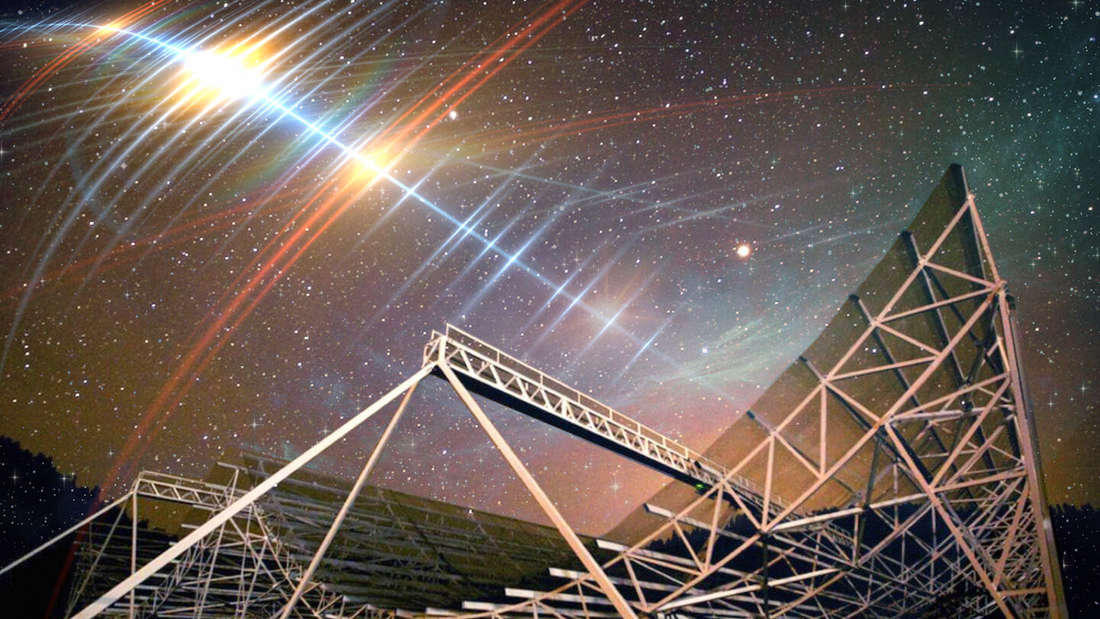A Canadian telescope picks up an unusual signal from the universe. The researchers determined that the mysterious signal had a “heartbeat”.
Cambridge – The infinite expanses of the universe are incredibly wonderful and beautiful, Also shown are the first images from the James Webb Space Telescope But researchers are far from understanding everything. A phenomenon that cannot be fully explained is the so-called “fast radio bursts” (abbreviated FRB). The term describes a very short wave (a few thousandths of a second in length) of radio radiation of unknown origin in space. In 2007 the first FRB was discovered, and since then hundreds of such fast cosmic flashes have been reported from different corners of the universe. But many questions about the mysterious signals – such as how they appeared or where they came from – remain unanswered to this day.
Researchers from the Massachusetts Institute of Technology (MIT) in Cambridge are now reporting an exciting radio burst from a distant galaxy. The mysterious new signal lasted for up to three seconds – about 1,000 times longer than the average fast radio burst. During this time window, the researchers were able to identify another feature: bursts of radio waves repeating every 0.2 seconds in a distinct periodic pattern — “similar to a beating heart,” according to a statement from the Massachusetts Institute of Technology.
A mysterious signal from the universe: “Boom, boom, boom – like a heartbeat”
“It was unusual,” recalls Danielle Mitchell, who discovered the signal in the Canadian Hydrogen Intensity Mapping Experiment (CHIME) in 2019. The researcher explains his discovery: “Not only was it very long at about three seconds, but there were also these periodic spikes that were remarkably precise and occurred in a fraction of a second — boom, boom, boom — like a heartbeat.”
The signal, designated FRB 20191221A, is believed to be complex, the longest-lived fast radio wavelength with the clearest periodic pattern detected to date. The mysterious signal appears to come from a galaxy billions of light-years from Earth. What exactly is the source of the signal is a mystery to researchers. However, they suspect that a radio pulsar or magnetar — both types of neutron stars — could be behind it.
satellite bulletin
Mysterious signals from the universe, strange celestial bodies in our galaxy, or views deep in space – with free space newsletter You are always on the lookout.
Unknown signal from space: “Magnetar or pulsar on steroids”
“There aren’t many things in the universe that emit strictly periodic signals,” notes Micheli, who led the study of the strange signal. The researcher continues: “In our galaxy, for example, we know about radio pulsars and magnetars that rotate and emit a beacon-like beam of emission,” adding: “We think this new signal could be a magnetar or a pulsar on doping.”
Micheli’s research team hopes to discover more periodic signals from a previously unknown source in order to use them as a kind of astrophysical clock. Researchers are particularly interested in the frequency of outbreaks and how they are changing. As the universe expands, the signal source moves away from Earth – researchers can use the variable frequency to measure how fast the universe is expanding.
It was unusual. Not only were they very long at about three seconds, but there were periodic spikes that were remarkably accurate and occurred in a fraction of a second — boom, boom, boom — like a heartbeat.
A mysterious “heartbeat” signal from the universe: incredibly bright and long
The unusual fast radio explosion was discovered by Micheli and his team Published in the journal Nature. In their study, the researchers showed that there are similarities with emissions from radio and magnetic pulsars in our Milky Way. But there is also a big difference: FRB 20191221A appears to be a million times brighter. Micheli believes that the bright flashes could have originated from a distant orb that is usually less bright but, for a previously unknown reason, was emitting a series of very bright explosions in a rare three-second window.
The researchers already know a few things about the mysterious signal and its source: “Based on the properties of this new signal, we can say that there is a plasma cloud around this source, which must be very turbulent,” explains Micheli. Additional bursts of the signal could help better understand the source and neutron stars. Michilli sums up the questions the researchers are asking: “This discovery raises the question of what could be causing this extreme signal that we haven’t seen before and how we can use this signal to study the universe.” (Tab)

“Total coffee aficionado. Travel buff. Music ninja. Bacon nerd. Beeraholic.”







More Stories
Exploding Fireball: Find the meteorite fragments
Neuralink's competitor lets blind people see again with an implant
A huge meteorite has hit Earth – four times the size of Mount Everest